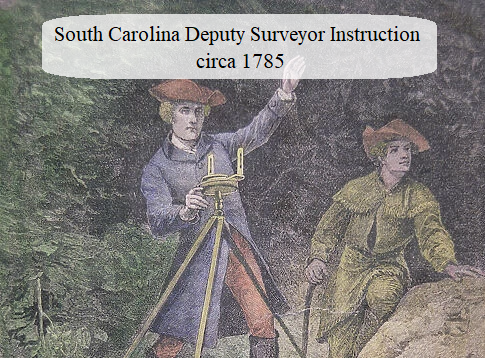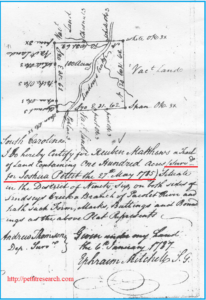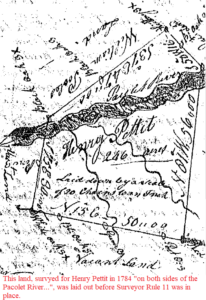c.1785 South Carolina Surveyor Instructions

At the end of this document you will find the full text of the South Carolina General Assembly’s official instructions for the State’s Deputy Surveyors in place by 1785. Studying these brief instructions will help researchers properly interpret and understand the land warrant and survey process in South Carolina and contextualize early grants of vacant land. The application of these surveyor “rules” is seen in surveys throughout South Carolina from at least 1785 and well into the 1800s. Below are some noteworthy highlights to keep in mind.
Elapsed Lands -Surveyed Land Not Claimed
The first thing to note is that no survey was to be conducted on vacant lands unless the grantee has first obtained a warrant from the Commissioner of Locations in the relevant District. If you find a recorded plat, you can be confident that whoever it was surveyed for, had requested and obtained a warrant for the same. Rule 1 states:
1st You shall not survey vacant land for any person who has not first obtained a warrant from the Commissioner of Locations of the District.
Sometimes, however, the grantee failed to complete the process and did not secure ownership of the land once he had it surveyed. Rules 5 and 10 deal with the process for surveying land that was granted but had “elapsed”. From the context of Rule 5 we see that “elapsed” land means it was first surveyed for someone who never completed the process to lay claim to it. Rule 5 states:
5th. Lands which have been heretofore surveyed, and remain elapsable in either of the location offices, or Surveyor General’s office, are not to be surveyed a second time, until a certificate is obtained from the office (in which they then are) of their being elapsable, and a warrant obtained from the office in the district where the land lies: which warrant shall expressly mention the land on which it is to be laid out, and that it has been formerly surveyed, and for whom
Rule 10 states:
10th Should any person wish you to survey lands for the purpose of obtaining a new grant for the same, you will be particular to mention in your certificate, that the land was formerly granted, and that the survey you then made was for the purpose of obtaining a new grant.”
An example of the application of this can be seen with a land grant that was issued to Reuben Matthews on January 6, 1787, in Spartanburg Co., SC. The plat, which was laid down by Andrew Thomson, Deputy Surveyor, states (emphasis added):
I do hereby certify for Reuben Matthews a tract of land containing one hundred acres (surveyed for Joshua Pettit the 27th May 1785) Situate in the District of Ninety Six, on both sides of Lindsey’s Creek, Branch of Pacolet River and hath such form, marks, buttings and boundings as the above plat represents.
Note that this land was originally surveyed for Joshua Pettit but he failed to secure it. A warrant was issued for Pettit and a survey run for him, but the land elapsed before Pettit gained final ownership. A new warrant was then issued from the 96 District office to Reuben Matthews. The plat specifically mentioned that it had been originally surveyed for Pettit as required by rules.
The Role of Neighbors When Property Was Surveyed
Rule 7 gives some interesting insight into the survey process when it had the potential for border line disputes. When re-surveying land that had been granted, if the lines that had been blazed were unrecognizable and/or the monuments missing, the surveyor was required to call the neighboring property owners together to reach an agreement on the lines. If they failed to reach an agreement, the matter was brought to the Judge of the Court of Common Pleas of Equity.
Rule 7 states:
7th When you are called on to re-survey granted lands, the original grant is your sufficient warrant; but if the line or lines are party lines, and are boundaries to other tracts, then you are to summon all parties to attend with their plats and grants, and to have their joint concurrence in your going on with the survey- if any dissention should arise between the parties, you must not proceed without an order from the Judge of the Court of Common Pleas or Equity…
New Land Surveys Not Permitted to Land-Lock Other Property
It is difficult to know the reasoning of some early speculators, but there are some examples of creative land grants that call to question their motives. In some cases, extremely narrow strips of land completely encompassing large parcels owned by others are at least suggestive of predatory practices. To limit the inevitable complications from granting or creating land-locked parcels, Rule 6 stated:
6th You are not to encompass wholly, or in part, any heretofore surveyed lands, claimed by any other person or persons than those you are surveying for.
Prior to the c.1785 instructions, it was not uncommon for granted land to include property on both sides of a navigable stream. There are several examples of this in Spartanburg County along the Pacolet River. For instance, 96 District Plat Book A, p42, records a survey of land that was warranted to Henry Pettit by the Commissioner of Locations on August 10, 1784, “on both sides of the Pacolet River…”
Though not the case with this particular grant, the problem with granting land encompassing streams was that industrious men would dam them up for the purpose of providing waterpower for mills. This was done at Clifton, Glendale, Pacolet, and numerous other sites up and down the rivers and creeks in the back country. This obviously obstructed the navigability of these streams and impeded the flow of commerce for those who used these waterways for shipping. Rule 11 made this much more difficult by enacting the following restriction:
You are not to survey any lands or marsh reserved for public purposes, nor cross in any of your surveys, any navigable river or creek.
c.1780 Deputy Surveyors Instructions for South Carolina
These instructions were recorded as supplementary notes in The Statutes at Large of South Carolina by Thomas Cooper, Vol 4, Containing the Acts from 1752, (exclusive) to 1786, (inclusive) published in 1838 at Columbia, SC. It would seem these instructions originated with one of the Acts passed to establish a mode for granting vacant lands after the Revolution. They were perhaps meant to accompany Act No. 1292, passed in 1785. The instructions were later codified into the revised statues of the State of South Carolina, found in Part I, Title I, Chapter VI, § 22.
Deputy Surveyor’s instructions.
TO
1st. You shall not survey vacant land for any person who has not first obtained a warrant from the Commissioner of Locations of the District.
2nd. In all your surveys, you are to measure the whole of the lines, unless prevented by such obstructions as may endanger health ; the figure of which you are to express on the plat, in the most explanatory manner, blazing the lines, and making a sufficient number of stations on each line, marked on the outside and corner tree or stake, at each angle mentioning those made by you, new, and those you find in the field, old; and no corner or station is to be inserted by you, unless seen or made by you; except such as are expressed on the bounding line in the authentic plat of the adjacent land : and that you verily believe them to be in the field; also, you are to insert in their proper places, all runs of water, roads, or other durable marks, which the line crosses; and all swamps, ponds, clear fields, and houses, if any there be, in the body of the tract, and the names of the persons claiming such lands, fields, or houses.
3rd. All plats made out by you, are to be just and true in the quantity contained, figure, courses, stations, marks and boundaries, to the best of your knowledge: plats of 100 acres, or under, to be laid down by a scale of ten chains per inch; all above 100 acres, by a scale of twenty chains; which scale you are to lay down or mention on the margin of the plats- you are to put down on each line the course and distance- you are to date your surveys on the day they are finished; and not to certify surveys performed by any other person.
4th. The Commissioners of Locations have a right to direct such warrants to the Deputy Surveyors as the nature of the case may require; but the Deputy Surveyor is not bound to pay any obedience to any directions therein contained, which are repugnant to these instructions; and all warrants are to bear date the day they are delivered out of the location offices. Any warrants delivered to any of the Deputy Surveyors, without a date, or any other part blank, are to be immediately returned to the owners, to have the blank filled up in the office from which it issued, and bear date on that day. Any Deputy Surveyor filling up any part of a warrant which is, or may be, left blank by the Commissioner of Locations, is hereby declared guilty of a violation of these instructions, and shall, in consequence thereof, be dismissed from the office.
5th. Lands which have been heretofore surveyed, and remain elapsable in either of the location offices, or Surveyor General’s office, are not to be surveyed a second time, until a certificate is obtained from the office (in which they then are) of their being elapsable, and a warrant obtained from the office in the district where the land lies: which warrant shall expressly mention the land on which it is to be laid out, and that it has been formerly surveyed, and for whom.
6th. You are not to encompass wholly, or in part, any heretofore surveyed lands, claimed by any other person or persons than those you are surveying for.
7th. When yon are called on to re-survey granted lands, the original grant is your sufficient warrant; but if the line or lines are party lines, and are boundaries to other tracts, then you are to summon all parties to attend with their plats and grants, and to have their joint concurrence in your going on with the survey- if any dissention should arise between the parties, you must not proceed without an order from the Judge of the Court of Common Pleas or Equity, directed to you for the express purpose; and, on receiving said order, you are to attend, first, to the course and marks of the prior grant; and should they differ from the course mentioned, you are to regulate your course by the stationed trees, and other marks, and fix the prior line thereby, (allowing what, variation you find,) which will be the proper bounds of both tracts; but should the two tracts run in such a manner as to form an angle between, and the marks on each appear plain, corresponding with each plat, that angle will be vacant, and each tract will be limited by its own lines, notwithstanding the subsequent mentions the prior as a boundary. In re-surveys, when lines vary from their original course, you are (where the marks are wanting) to continue the same variation throughout, in such tracts as were bounded on all sides by vacant land at the title of the original survey; but where they have been bounded on different surveys, you are to allow, on each line, the variation of the lines of the tract on which the line bounded.
8th. When you are called on to survey lands, where the lines are entirely obliterated, then then you are to have recourse to the boundaries, which, when fixed, will form the lines of said lands; but if the boundaries were vacant at the time of the original survey of said lands, then you are to have recourse to such lands as bound upon it, whose courses correspond with the lines of said tract, allowing such variation as appears to have proceeded from time. When that allowance is not sufficiently made, you will find the original line on your left hand in all cases, except where a variation happens which is occasioned by a bad instrument; but when the allowance is judiciously attended to, you will find your present course and the original line to agree.
9th. In all cases whatever, you arc to administer the following oath to the chain carriers: “You, A, B and C, D, do solemnly swear, that you will well and faithfully execute the employment of chain carriers, without favor or affection: So help you God.”
10th. Should any person wish you to survey lands for the purpose of obtaining a new grant for the same, you will be particular to mention in your certificate, that the land was formerly granted, and that the survey you then made was for the purpose of obtaining a new grant.
11th. You are not to survey any lands or marsh reserved for public purposes, nor cross in any of your surveys, any navigable river or creek.
12th. You will be particular, always, in making your lines; let there be no possibility of mistake hereafter—with a view to this, you will never run more than ten chains, at the extent, without leaving a station exactly on the line, observing never to mark it with the ┼ unless it be a corner post.
13th. In locating lands, you will observe the established principles laid down by the decisions of the Court of Appeals of this State.
14th. You will be particularly careful always to have the best of instruments. Touch your needle with the magnet at least once a year, and oftener if necessary; your staff should be furnished with a ball and socket. There is no excuse for a surveyor going into the field witl1 a bad instrument.
15th. Your chain must be often inspected, and preserved entire.
16th. In plotting, great attention and nicety is required to ensure accuracy your work must always close neatly-it must never be forced, but carefully revised and corrected. Sometimes, indeed, where great attention is not paid in the first instance, it will be necessary to return to the field, where errors most frequently originate.
17th. Sobriety AND steadiness must be observed as well in respect to your men as to yourself, else there can be no reliance upon your work.
18th. In all surveys made by you, by order of Court, the plat you return must be laid down by a scale of ten chains to an inch, and to designate, by dotted lines, each separate tract, if more than one grant.
19th. No plat will lie entered in the office for record, without at least one station on every line.
Download PDF Version of this Document
A PDF version of this information is available here. Feel free to download and distribute in its original form.
If you found this helpful, please leave me a comment below!

